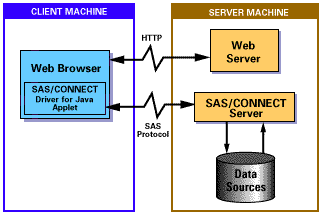| SAS/CONNECT 9.2 Driver for Java |
How SAS/CONNECT Driver for Java Works
With the SAS/CONNECT driver for Java classes, you can interactively submit SAS statements and retrieve log and output information. A Java program uses the SAS/CONNECT driver for Java classes to start a SAS/CONNECT session on the server machine and establish a connection to that session. Each program creates a SAS session for its use. SAS/CONNECT sessions are not shared between multiple users or multiple programs. The SAS session is destroyed when the program completes. After the program has established a connection to the remote SAS session, the applet can submit SAS statements and retrieve the log lines and output generated from those statements.
The SAS/CONNECT driver for Java provides classes that use either socket-based communication or the tunnel feature. Socket communication with applets can be restricted by the Java security manager. The security manager is provided by the browser, and each browser has a different set of restrictions imposed on applets. Most security managers restrict socket-based communication and only allow applets to open socket connections to the same machine that provided the applet classes. This means the SAS/CONNECT session and the Web server that provides the Java classes must run on the same machine. The tunnel feature eliminates this restriction, enabling you to provide your Web server and your SAS/CONNECT session on different machines.
The following diagram shows how all the components work together when you are using a Java applet. The Web browser on the client machine requests an HTML document from the Web server. The server responds by sending the document to the browser. If the browser detects an applet tag in the document, it sends additional requests to the Web server for the Java classes used by the applet. After the classes are downloaded to the client machine, the applet begins running.
Copyright © 2007 by SAS Institute Inc., Cary, NC, USA. All rights reserved.
